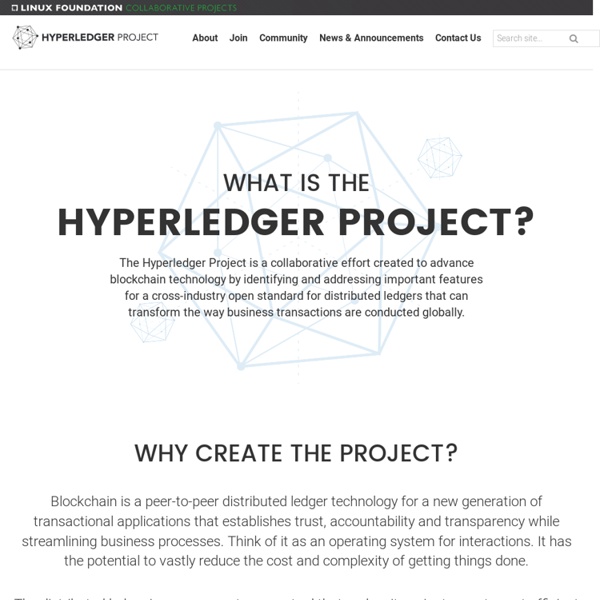



https://www.hyperledger.org/home
Related: BlockChain • BlockChainsBuilding Blockchain in Go. Part 1: Basic Prototype · Going the distance Chinese translations: by liuchengxu, by zhangli1. Introduction Blockchain is one of the most revolutionary technologies of the 21st century, which is still maturing and which potential is not fully realized yet. In its essence, blockchain is just a distributed database of records. But what makes it unique is that it’s not a private database, but a public one, i.e. everyone who uses it has a full or partial copy of it. And a new record can be added only with a consent of other keepers of the database.
Sirius to power LOGYCA Supply Chain Value NetworkProximaX Official Blog Bogotá, Colombia, 24th August 2020 – ProximaX recently signed an agreement with LOGYCA to develop a platform utilizing blockchain technology to power their Supply Chain Value Network (“SCVN”). LOGYCA is a pioneer and a leader in logistics knowledge development, and innovator in SCVN for different economic sectors in Colombia and Latin America. SCVN is a next stage evolution of Supply Chain. It reconciles the Supply Chain with Porter’s model. Through collaborative work, communities are formed to generate value by adopting globally accepted standards and introducing best logistics practices in inter-company processes. Under the framework of this project, “Transformation of B2B Information Exchange”, ProximaX and LOGYCA will come together to develop a collaborative platform to address the limitations of traditional technology.
A comprehensive guide to coding a blockchain-powered online community At Hashnode we have been experimenting a lot with blockchain and its use-cases. We have been running a developers’ community ourselves, and the idea behind “decentralized communities” fascinates me a lot. The fact that everyone owns the data and controls the platform can give rise to new types of social apps and disrupt the traditional way of building online communities.
How blockchain will disrupt business This ebook, based on the latest ZDNet and TechRepublic special feature, looks at how blockchain is shaking up the economy, redefining industry, and changing the way individuals and enterprises conduct business. From the ebook: The term blockchain can elicit reactions ranging from a blank stare (from the majority of the general public) to evangelical fervour (from over-enthusiastic early adopters). But most people who know a bit about the technology detect a pungent whiff of hype, leavened with the suspicion that, when the dust settles, it may have a significant role to play as a component of digital transformation. The best-known example of blockchain technology in action is the leading cryptocurrency Bitcoin, but there are many more use cases—think of blockchain as the ‘operating system’ upon which different ‘applications’ (such as Bitcoin) can run. So, what is a blockchain?
bitaddress.org A Bitcoin wallet is as simple as a single pairing of a Bitcoin address with its corresponding Bitcoin private key. Such a wallet has been generated for you in your web browser and is displayed above. To safeguard this wallet you must print or otherwise record the Bitcoin address and private key. It is important to make a backup copy of the private key and store it in a safe location. This site does not have knowledge of your private key. What is Blockchain Technology? A Step-by-Step Guide For Beginners Share and get +16+16 The blockchain is an undeniably ingenious invention – the brainchild of a person or group of people known by the pseudonym, Satoshi Nakamoto. But since then, it has evolved into something greater, and the main question every single person is asking is: What is Blockchain? Is Blockchain Technology the New Internet? By allowing digital information to be distributed but not copied, blockchain technology created the backbone of a new type of internet.
Quickstart · IOST Docs This page provides a guide for different kinds of users to find out which parts in the documentations to look at. If you want to know IOST basic concepts Before you get into IOST technical details or developing smart contract on IOST, it is helpful to know IOST basic concepts at first and have a thorough understanding about IOST. You can learn some basic concepts about IOST's account system, economic model, vote process. If you want to use IOST You can join IOST community and contribute to IOST daily operation even if you are NOT a developer. Blockchain Just Became Obsolete. The Future is Hashgraph Swirlds is a software platform that has developed the hashgraph consensus algorithm: an entirely new distributed ledger technology that is much more cost-effective (no proof-of-work), 50,000 times the speed, safer (Byzantine), more efficient (no stale blocks) and mathematically fairer than the blockchain. This is the future of the internet and decentralized technology. What is Blockchain Technology? Considered the greatest technological innovation since the internet: Blockchain technology emerged in response to the collapse of several banking institutions in 2008 with the release of a whitepaper by Satoshi Nakamoto titled: “Bitcoin: A Peer-to-Peer Electronic Cash System.” “…blockchain technology facilitates peer-to-peer transactions without any intermediary such as a bank or governing body …”